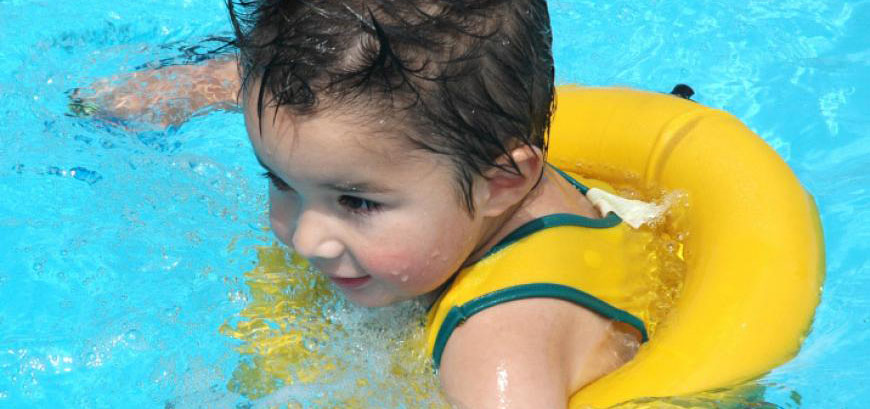
Whether you’re bathing your baby or taking your kids to the local pool, water safety matters at every age. Drowning and other water injuries are preventable—yet drowning is one of the leading causes of death for children ages 1 to 4, according to the Centers for Disease Control (CDC). Water-related deaths and injuries are also a serious problem among teenagers, especially boys. Understanding the basics of water safety for children can help prepare you to keep your kids safe around the water—today, and as they grow older.
Supervise Your Kids
When it comes to water safety for children, there’s no substitution for adult supervision. Watch your kids carefully whenever they are playing in water—whether in the bathtub or at the lake.
If you take your kids swimming, the Red Cross notes that you should always keep young children within arm’s reach. And don’t hesitate to get wet yourself if a child is struggling.
Take special care during pool parties and other social events, when it’s easy to get distracted. Assign an adult to stay sober and actively supervise the kids. You should also take regular headcounts to make sure that every swimmer is accounted for.
When visiting public pools or beaches, choose locations staffed by a lifeguard. But don’t get complacent! Lifeguards have many people to supervise; keeping your kids safe remains your responsibility.
Around the House
Infants can drown in one inch of water, and most accidents involving infants and water happen in the bathtub, warn experts at the Phoenix Children’s Hospital. When bathing your baby or toddler, maintain eye-to-eye contact and never leave them alone. Bring everything into the bathroom with you, so you don’t have leave to fetch a towel or change of clothes.
Once kids begin to crawl and climb, other areas of the house may pose water-related dangers. Keep mop buckets, fish tanks, and other containers of water out-of-reach for toddlers and young children.
Around the Pool and Backyard
Water safety for children is important for all pool owners, whether they have kids of their own or young neighbors. Even if your pool is inflatable or portable, it’s vital to take precautions. Backyard water hazards may exist in many forms, including hot tubs and ornamental ponds.
Many areas have laws requiring fencing around a pool. Even if you live in an area without specific requirements, the Red Cross recommends installing a fence to separate your pool from the street, your house, and the rest of your yard. The fence should be five feet tall or higher, built from material that is not easily climbed, and kept in good repair to prevent young children from getting through it or over it. The gate should be self-closing, self-latching, and locked when not in use. In addition, take the time to move items that a child could use to scale the fence, including shrubs, chairs, or playground equipment.
If you have a pool with a filtration system, consider investing in protective drain covers. The American Academy of Pediatrics notes that children can become ensnared by the suction from uncovered drains, which may trap small hands, feet, or even hair.
The Red Cross also suggests maintaining a stock of appropriate rescue equipment, such as a shepherd’s hook, lifesaving ring, and first aid kit. Keep a phone nearby, with the local emergency number (ie. 9-1-1) posted somewhere visible.
If a child goes missing, check the pool area first! The Red Cross notes that seconds count when it comes to preventing serious injury or death.
At the Beach
A day at the beach can be lots of fun, but it brings some risks for young swimmers. The Red Cross advises against letting kids swim alone. Even if they are wearing a life jacket or playing with floating toys, they still need supervision.
Before entering the water, check online, review local signage, talk to lifeguards, and survey the waterfront to check for safety issues, like cold temperatures, waves, currents, undertows, and high levels of bacteria or pollution. On days when it’s not safe to swim, stick to sand castles instead. And don’t forget to wear sunscreen!
On a Boat
The U.S. Coast Guard estimates that 80% of boating-related fatalities could be prevented with proper lifejacket use. When boating, bring well-fitted lifejackets for all on board, and make sure everyone wears them.
Don’t forget to pack other safety equipment too, including a buoyant rescue line, bailer or manual pump, and emergency sound-signaling device, like a whistle or horn.
Watch out for other people in and on the water, and avoid designated swimming areas.
Older Kids and Teenagers
Water safety for kids is important at every age! In fact, experts at the Phoenix Children’s Hospital note
teenagers – especially boys – are one of the highest risk age groups for drowning in open water, including rivers, lakes, and oceans.
Alcohol is involved in too many of those incidents. According to the World Health Organization, alcohol plays a role in 25% to 50% of drownings among adolescents and adults in the U.S.
Remind older children and teenagers of water safety rules, including the importance of swimming with a buddy. Consider if you should discuss the safety risks of underage drinking, and the importance of staying sober while swimming and boating.
HealthAhead Hint: Be Prepared
Although learning to swim is no guarantee that you and your children will stay safe around water—it’s a good place to start. The Red Cross recommends that everyone in your family learn to swim well. Consider enrolling in swimming lessons and a water safety program. You may also find it useful to take a course in CPR. With the right knowledge, skills, and tools, you and your family can stay safe around water.
